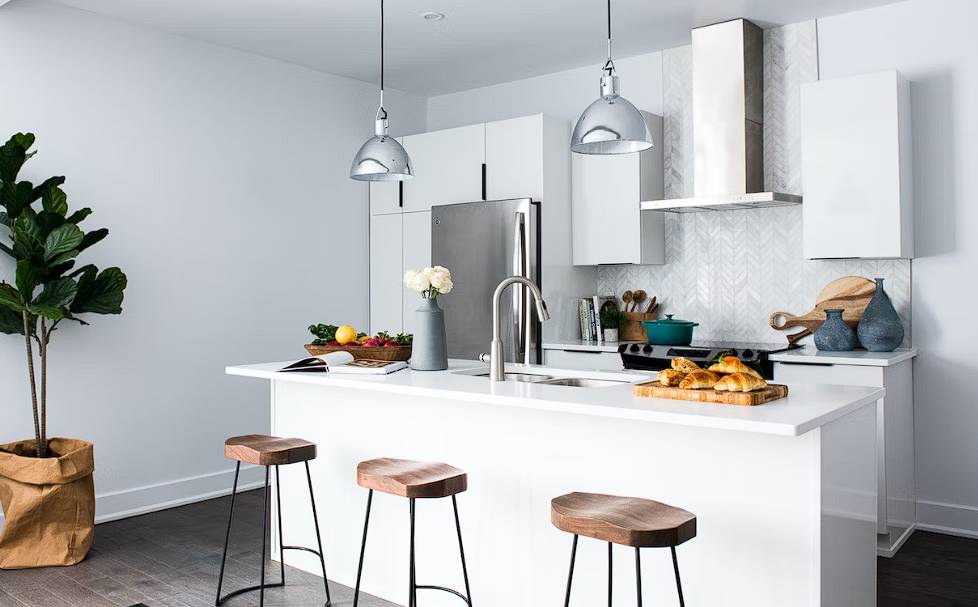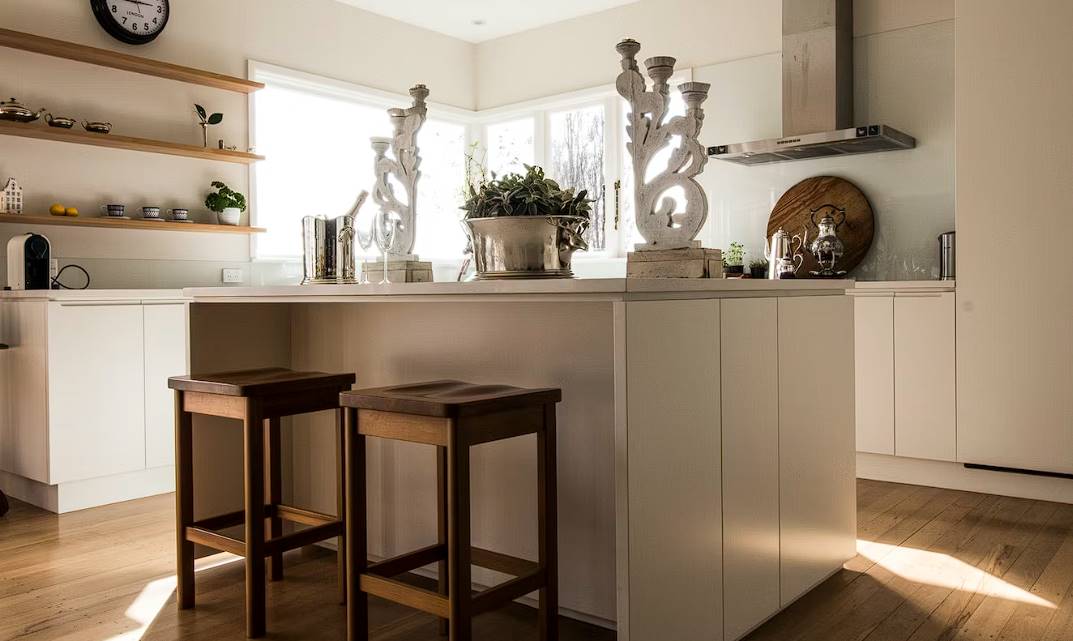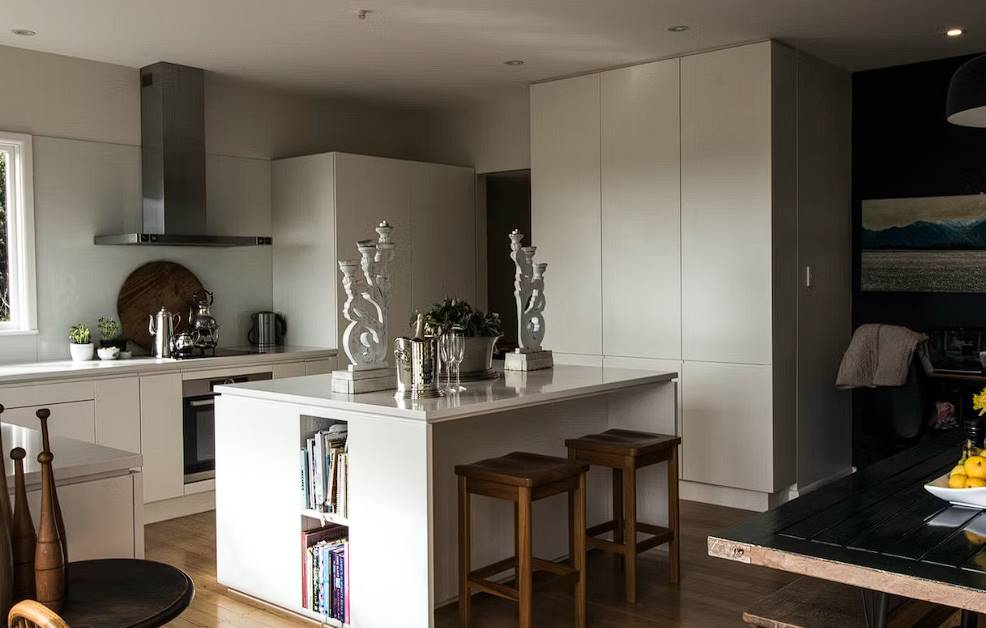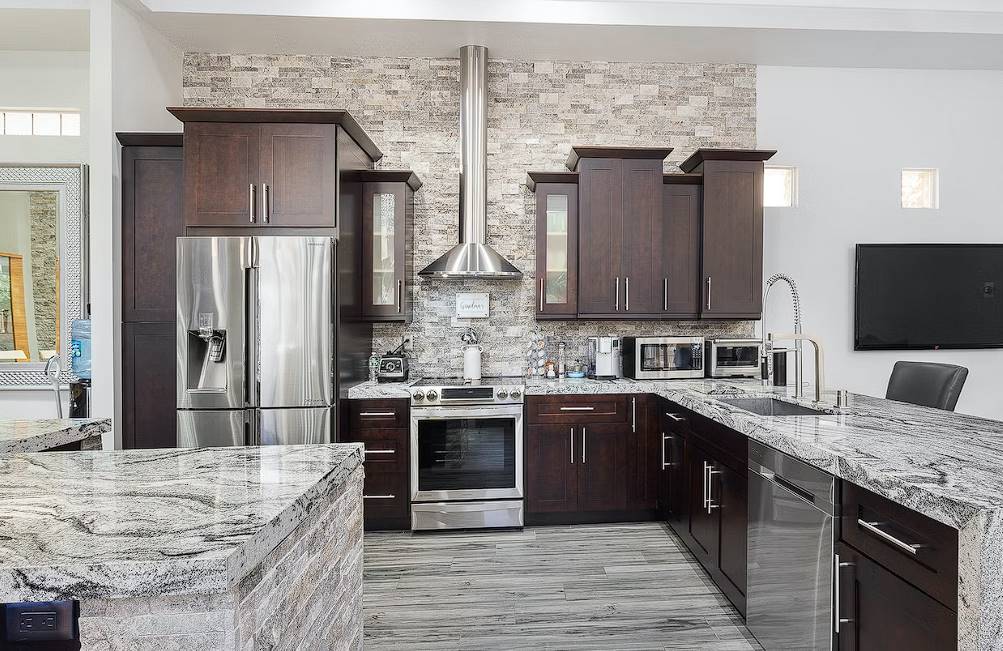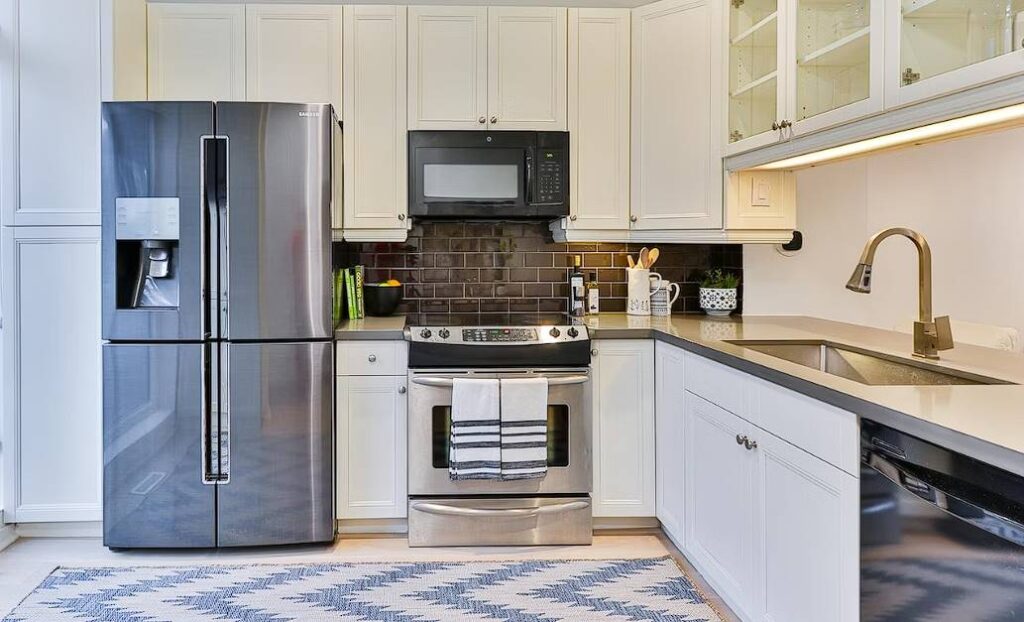The cabinets are one of the most noticeable aspects of your ideal kitchen. Kitchen cabinet door styles, kinds, and materials are all important factors to think about. Your kitchen's design, colour palette, and, of course, your remodelling budget will all play a role in the material you decide to use for your cabinets.
Kitchen cabinets are multi-part structures from solid hardwood or softwood timber to veneered timber or even artificial boards. But, again, there is some debate over the appropriate materials for the various parts of a cabinet, such as the carcasses, drawers, interior linings, shelving, and doors.
How Do You Pick The Best Materials For Your Kitchen Cabinets?
The right cabinetry can make a space look like a million dollars, so knowing what you're working with is important. In addition, it is essential to invest in high-quality cabinetry if you want it to last and add value to your home.
There are wonderful cabinet options for every budget, whether you are remodelling your forever home kitchen or performing an instant bathroom upgrade.
The following compares the pros and cons of seven of the most often-used materials for kitchen cabinetry.
High Pressure Laminate
Laminate is made by pressing together resin and the coloured or patterned paper of your choice under high heat. It's a finish that gets adhered to the plywood or fibreboard that makes up the carcass of the cabinet.
The price, durability, and likelihood of laminate peeling from its core component depend on its quality. Compared to low-pressure laminate (LPL), high-pressure laminate (HPL) is more resistant to cracking and chipping.
Pros:
- Tough to the touch. HPL is produced using many layers and high pressure; thus while it is comparable to melamine, it is not the same. This makes the material less likely to sustain damage from impacts, such as chips or scratches.
- Selection. HPL cabinets are available in an amazing variety of colours and textures.
- Simple to take care of. This material can be used as-is; no finishing or staining is necessary.
Cons:
- Price. High-pressure laminate costs more than melamine but less than many other materials.
Kitchen designers and manufacturers sometimes have differing views on the best materials for cabinets. Kitchen cabinets are multi-part structures manufactured from various materials, including but not limited to solid hardwood and softwood timber, veneered timber, and artificial boards. Again, there is debate over the appropriate materials for the various parts of a cabinet, such as the carcasses, drawers, interior linings, shelving, and doors.
The material used in constructing cabinet frames should be strong and reliable. Cabinet frames manufactured from solid lumber and plywood are long-lasting and common.
Melamine
Melamine is a plastic laminate surface layered on top of wood or fibreboard. Melamine, like laminate, is manufactured by pressing paper and resin together under heat, although it is less expensive.
The quality of melamine can be gauged by its various degrees. Poorly made melamine will not last as long as laminate. However, textured thermal-fused melamine has the potential to outlast HPL due to its increased thickness and durability.
Pros:
- Price. Melamine is the most budget-friendly option, and it's made by applying a layer of paper dyed with heat-fused melamine resin on a base of pressed wood, MD, or plywood.
- Variety. There is a wide variety of colours and designs, including some very realistic-looking imitations of wood grain and textured melamine.
- Maintenance. Melamine cabinets don't need to be refinished or sealed like timber ones.
Cons:
- Limited Variety of Shapes. The square nature of the cabinets limits your creativity in terms of layout.
- Low Resistance. Melamine cabinets are notably scratch and dent-prone, making repairs difficult or impossible.
- Weight. Melamine is more likely to cause sagging cabinets than more expensive materials.
Polyester
Pros:
- Price. Melamine is combined with pine fibre, coated in a polyester film. Although it is more expensive than melamine, it’s still very affordable.
- Tougher to break down than melamine. Polyester's scratch resistance is much higher than that of melamine's.
- Colour selection. Cabinets made from polyester come in various hues and wood finishes.
Cons:
- Scratch Repair Finishing Difficulty. Retouching polyester that has been scratched is a challenging procedure.
Wood Veneers
Hardwood is peeled or sliced into thin layers to create veneer. Veneers are glued onto plywood, MDF, or particle board to make panels seem like wood. They can give the impression of wood without the weight or expense of real wood cabinet doors. Wood veneers are a great option if you want your cabinets to have a finished look and feel.
Pros:
- The appearance of real wood. Veneer cabinets mimic the look and texture of genuine wood while being constructed from a cheaper core material and a thin coating of real wood.
- Price: Veneer is a cheaper alternative to solid wood.
- Easy Scratch Fixing Polishing out minor flaws like nicks and scratches leaves a surface looking as good as new.
- Durability. Wood veneer is more durable than laminate but less long-lasting than real wood. It takes a lot of work to warp.
- Incredibly Low Maintenance. A soft damp cloth is all that's needed to clean veneer cabinets.
Cons:
- Permeable to the effects of water. The veneer will get "bubbled" and lose its smooth appearance if exposed to too much moisture.
Medium-Density Fiberboard (Mdf)
Medium-density fibreboard (MDF) is another manufactured product that differs from HDF in density due to the lower pressures used in its production. It's a common base for decorative cabinet finishes like veneer and laminate.
Cabinets made from engineered wood often include an MDF core. The ideal applications are cabinet doors, drawer faces, and shelf backs.
Pros:
- Equal Measures. MDF's smooth, consistent grain comes from the tiny wood fibre particles that make up the material, along with the wax and resins.
- Stability. When the humidity in your home rises and falls, MDF won't swell and shrink like real wood would. This will make it more resistant to warping.
- Paintability. MDF cabinets can easily be painted over and refinished whenever you choose.
- Modular Fashion. Kitchen cabinets made from medium-density fibreboard can be easily customised to suit individual tastes.
- Large-size pieces. Unlike wood, which is constrained by the size of the tree it is cut from, MDF is produced in huge pieces.
Cons:
- Not Sandable. Sanding MDF makes it tough to remove chips and scrapes.
- Not resistant to heat. Extremely high temperatures will not be withstood by this cabinet material.
Solid Wood
Given its natural beauty, strength, durability, lifespan, and versatility for varied styles, solid wood is one of the most prefered materials for kitchen cabinets, despite being a more expensive option. Wood cabinets are unique because no two planks of wood are the same. Wood cabinets can be stained, painted, or left natural, and they can be made to look like almost any kind of wood.
The face frames and doors of cabinets are traditionally made of solid wood.
Pros:
- Always in style. The classic elegance that wood cabinets give to a home will always remain in style.
- The spectrum of natural hues is wide. Natural colours like these can be found in many different types of wood, including bamboo, cherry, oak, birch, walnut, maple, knotty pine, and hickory.
- Durable. Cabinets made of wood are sturdy, durable, and difficult to damage. It's easy to paint over or rub out most scratches.
- Customizable. The type of cabinet door you want can be easily shaped from solid wood.
Cons:
- Price. Cabinets made of solid wood are typically more costly.
- Response to Humidity. As a result of its sensitivity to moisture, solid wood can naturally distort and split.
- Hard to maintain. Waterproof varnish is recommended for wooden cabinetry. Use nonabrasive cleaners made of wood, if possible.
High Gloss Thermofoil
Pros:
- Nice Appearance. High gloss thermofoil is made of a base material like pine fibreboard and a glossy vinyl finish. By reflecting light, these cabinets provide the impression that your kitchen is larger and brighter.
- Simple to clean. Use a moist, non-scratch cloth to remove any fingerprints or other blemishes..
- Never fade or stretch. HGT cabinets won't crack or split as easily as wooden ones do over time.
Cons:
- Display the dirt. Many parents of young children avoid using this material for lower cabinet doors because it shows every fingerprint and smudge.
- Painted with difficulty. It's difficult to alter the hue or hide the scratches.
- Heat and moisture sensitivity Although modern HGT cabinets are more sturdy than those of a decade ago, they are nevertheless susceptible to damage.
Considering The Cabinets' Construction
Considering that cabinet doors are not load-bearing, material strength is less crucial, yet, the doors must still be able to withstand wear and tear. The desired finish is a common deciding factor when selecting a material for cabinet doors. Many designers select tulipwood for painted kitchen cabinet ideas because it has a subtle texture and accepts paint nicely.
Anatomy Of A Cabinet
The materials used to make kitchen cabinets vary greatly since each reflects a different degree of quality, durability, look, and cost.
A basic understanding of cabinet construction will help you choose the finest cabinet material because different areas of a cabinet can benefit from certain materials more than others.
Cabinet Box
The cabinet box, to which the frame is attached, is where goods are kept within the cabinet.
Cabinet Door Overlays
Styles for cabinet door overlays include:
- Inset - Where the door is installed so that its face is even with the frame and all of the in-frame content is visible.
- Partial Overlay - Where the door rests above the frame, revealing the top two or three inches of the surround.
- Full Overlay - When the cabinet doors entirely hide the cabinet box frame.
Cabinet Frame
The front of the cabinet box is where the cabinet frame is fastened. It's where the doors in a framed cabinet box frequently attach. Framed cabinets include additional wood pieces covering and "framing" the cabinet box opening.
Frameless cabinets omit the frame and other wood from the cabinet box for a simpler, more streamlined form. As a result, frameless cabinets need a stronger, thicker foundation material to withstand use and storage.
Cabinet Panels
Kitchen cabinet panels hide the unfinished backs of base cabinets, wall cabinets, and islands. Decorative end panels, panels for appliances like refrigerators and dishwashers, and more are all available as panels. Panels are meant to "finish" unfinished cabinets with a uniform appearance.
Use The Right Material To Make The Most Of Your Cabinets
Your kitchen cabinets made of higher-quality materials will be stronger, more long-lasting, and even raise the value of your property if and when you decide to sell. The materials will endure longer the greater the quality of the materials.
Cheaper, lower-quality, or less durable cabinets may be more prone to damage or may not last as long as their more expensive, more durable counterparts. And because of this, you'll need to replace your cabinets much more quickly, which could cost you more over time.
Consider that spending a bit extra on kitchen cabinets now could save you a lot of money and hassle later on. If you want your money to last, investing in quality kitchen cabinets is a good idea; knowing about cabinet materials will help you make that decision.
Conclusion
Kitchen cabinets are essential components of a home, and selecting the right materials for them is crucial for their longevity and value. There are various materials available for kitchen cabinets, including high-pressure laminate (HPL), melamine, polyester, wood veneers, medium-density fiberboard (MDF), solid wood, and solid wood. High-pressure laminate (HPL) is more resistant to cracking and chipping, making it a popular choice for its durability, variety, and ease of maintenance. Melamine is a plastic laminate surface layered on top of wood or fibreboard, with varying degrees of quality.
Polyester is a more affordable option, but it is more difficult to break down and has a higher scratch resistance. Wood veneers mimic the appearance of real wood but are less durable than laminate. They are also easy to clean and maintain, but may be permeable to water. Medium-density fiberboard (MDF) is a common base for decorative cabinet finishes like veneer and laminate, with advantages such as equal measurements, stability, paintability, modular fashion, and large-size pieces.
Solid wood is a popular choice due to its natural beauty, strength, durability, lifespan, and versatility for various styles. Its face frames and doors are traditionally made of solid wood, offering timeless elegance, a wide range of natural hues, durability, and customization. However, it is not suitable for all kitchens due to its high cost and limited selection of materials. Solid wood cabinets are more expensive and can distort and split due to their moisture sensitivity. They are also difficult to maintain, with waterproof varnish recommended.
High gloss thermofoil cabinets offer a nice appearance, easy cleaning, and won't fade or stretch over time. However, they can display dirt, be difficult to paint, and be susceptible to heat and moisture sensitivity.
When selecting cabinet doors, consider the desired finish and the material strength. Tulipwood is a popular choice for painted kitchen cabinets due to its subtle texture and paintability. Cabinet construction varies greatly, with different materials reflecting different qualities, durability, and appearance. Understanding cabinet construction helps choose the best material for different areas of a cabinet.
Cabinet boxes, door overlays, cabinet frames, and cabinet panels are essential components in kitchen cabinets. Higher-quality materials are stronger, more long-lasting, and can even increase the value of your property if you decide to sell. Cheaper, lower-quality, or less durable cabinets may be more prone to damage or may not last as long as their more expensive counterparts. Investing in quality cabinets now can save money and hassle in the future.
Content Summary:
- Kitchen cabinet door styles, kinds, and materials are all important factors to think about.
- Your kitchen's design, colour palette, and, of course, your remodelling budget will all play a role in the material you decide to use for your cabinets.
- But, again, there is some debate over the appropriate materials for the various parts of a cabinet, such as the carcasses, drawers, interior linings, shelving, and doors.
- In addition, it is essential to invest in high-quality cabinetry if you want it to last and add value to your home.
- The following compares the pros and cons of seven of the most often-used materials for kitchen cabinetry.
- Compared to low-pressure laminate (LPL), high-pressure laminate (HPL) is more resistant to cracking and chipping.
- The material used in constructing cabinet frames should be strong and reliable.
- Cabinet frames manufactured from solid lumber and plywood are long-lasting and common.
- Melamine is a plastic laminate surface layered on top of wood or fibreboard.
- However, textured thermal-fused melamine has the potential to outlast HPL due to its increased thickness and durability.
- Maintenance.
- The square nature of the cabinets limits your creativity in terms of layout.
- Melamine cabinets are notably scratch and dent-prone, making repairs difficult or impossible.
- Polyester's scratch resistance is much higher than that of melamine's.
- Cabinets made from polyester come in various hues and wood finishes.
- Veneer cabinets mimic the look and texture of genuine wood while being constructed from a cheaper core material and a thin coating of real wood.
- Price: Veneer is a cheaper alternative to solid wood.
- Medium-density fibreboard (MDF) is another manufactured product that differs from HDF in density due to the lower pressures used in its production.
- It's a common base for decorative cabinet finishes like veneer and laminate.
- Cabinets made from engineered wood often include an MDF core.
- MDF cabinets can easily be painted over and refinished whenever you choose.
- Kitchen cabinets made from medium-density fibreboard can be easily customised to suit individual tastes.
- The face frames and doors of cabinets are traditionally made of solid wood.
- Pros: Always in style.
- Cabinets made of wood are sturdy, durable, and difficult to damage.
- The type of cabinet door you want can be easily shaped from solid wood.
- Cabinets made of solid wood are typically more costly.
- Waterproof varnish is recommended for wooden cabinetry.
- Painted with difficulty.
- Heat and moisture sensitivity Although modern HGT cabinets are more sturdy than those of a decade ago, they are nevertheless susceptible to damage.
- Considering that cabinet doors are not load-bearing, material strength is less crucial, yet, the doors must still be able to withstand wear and tear.
- Full Overlay - When the cabinet doors entirely hide the cabinet box frame.
- The front of the cabinet box is where the cabinet frame is fastened.
- It's where the doors in a framed cabinet box frequently attach.
- As a result, frameless cabinets need a stronger, thicker foundation material to withstand use and storage.
- Kitchen cabinet panels hide the unfinished backs of base cabinets, wall cabinets, and islands.
- Panels are meant to "finish" unfinished cabinets with a uniform appearance.
- Your kitchen cabinets made of higher-quality materials will be stronger, more long-lasting, and even raise the value of your property if and when you decide to sell.
- The materials will endure longer the greater the quality of the materials.
- And because of this, you'll need to replace your cabinets much more quickly, which could cost you more over time.
- Consider that spending a bit extra on kitchen cabinets now could save you a lot of money and hassle later on.
- If you want your money to last, investing in quality kitchen cabinets is a good idea; knowing about cabinet materials will help you make that decision.
Frequently Asked Questions
Cleaning your glasses daily is not mandatory, but it is highly recommended to prevent eye strain. Regular cleaning helps maintain optimal vision by removing dirt, oil, and smudges that accumulate on the lenses. By keeping your glasses clean, you ensure that your eyes can see through them clearly without the need for additional effort, reducing the risk of eye strain.
Keeping your glasses clean offers several additional benefits beyond preventing eye strain. Clean glasses provide clearer vision, enhancing your overall visual experience. Moreover, clean glasses reduce the risk of smudging your lenses or obstructing your view due to dirt and fingerprints. By maintaining clean glasses, you also extend the lifespan of the lens coatings and prevent potential damage that could compromise their functionality.
Yes, dirty glasses can worsen existing eye conditions. Individuals with conditions like astigmatism or nearsightedness rely on glasses to correct their vision. When these glasses are dirty, the visual correction they provide becomes compromised. The dirt or smudges on the lenses can amplify the existing vision problems, making it harder to see clearly and potentially exacerbating the symptoms associated with the condition.
Yes, dirty glasses can contribute to headaches and eye pain. When you wear glasses with smudges or dirt, your eyes may have to strain to compensate for the reduced clarity. This constant effort can lead to eye muscle fatigue and tension, which can trigger headaches. Additionally, the strain on your eyes can cause discomfort and pain in and around the eye area.
When cleaning glasses, it's best to use a mild soap specifically formulated for eyewear or a lens cleaning solution. Avoid using harsh chemicals, ammonia-based cleaners, or abrasive materials as they can damage the lens coatings. To clean your glasses, gently rub the lenses with your fingertips or a soft, lint-free cloth in a circular motion. Rinse them thoroughly and pat dry with a clean microfiber cloth to avoid scratching the lenses.

